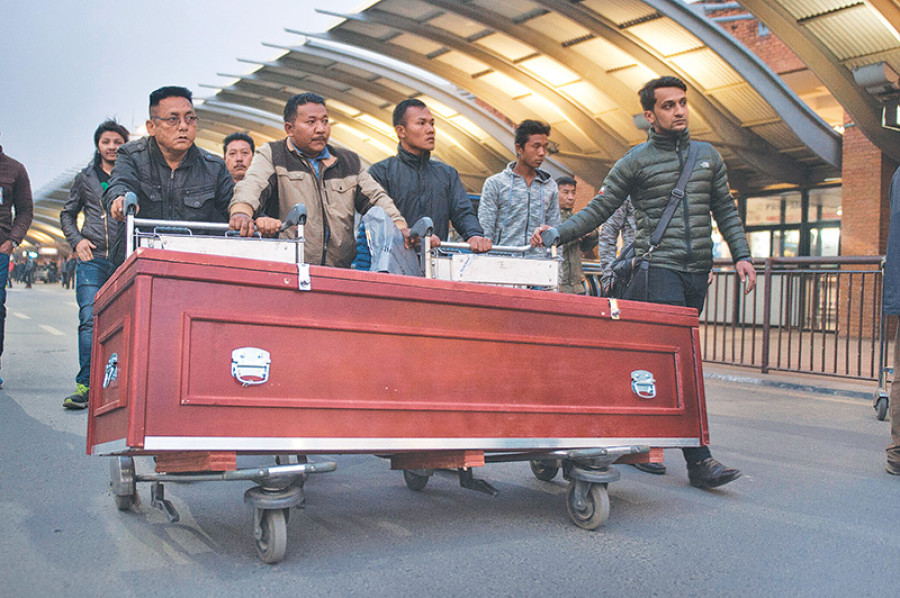Miscellaneous
Those who die young, and in vain
We are raising a new Nepal from the ashes and bones of our dead, young people. If you don’t believe in what I am saying, go and see the layers of the country’s newly-built foundation.
Abhinawa Devkota
We are raising a new Nepal from the ashes and bones of our dead, young people. If you don’t believe in what I am saying, go and see the layers of the country’s newly-built foundation. The first layer is made up of those who died during the Maoist insurgency. They were young boys and girls from villages who had been brainwashed into carrying arms and killing others. They were low-ranking, meagerly paid, ill-treated and ill-equipped police and military personnel who were, in most of the cases, just obeying orders from above. They were innocent civilians, mostly peasants, who were caught between the army and the insurgents.
On top of this layer, if you examine closely, you will see the remains of the Madheshis and janajatis who died, or were killed, during various movements demanding equal rights and opportunity. And finally, on the top of them all, you will see the scattered remains of those who left this country to work abroad hoping to bring an end to the poverty and hardships they had been facing for so long.
All young. All dead.
Death comes unbidden to all. But while for some privileged ones it is an abstraction that one encounters in an old age at home, age care centre or a hospital, surrounded by family, friends and relatives, for many, especially in a country like ours, it comes early and leaves behind painful consequences. It is a result, not of some disease that takes you to the doctor when your bones have shrunk or your skin has wrinkled, but of the struggle that one has to face while trying to live, or eking out a living by whatever means possible.
Death, for them, was the price they were forced to pay while trying to carve a better future, if not for them then for those after them. And it did not matter whether they chose to stay at home or go abroad. If the condition at home was oppressive, the condition abroad turned out to be equally intolerable.
A Man Bahadur Bishwokarma, 32, dies during his sleep in Saudi Arabia after working overtime for months in a hot weather. A Sarita Tamang, 18, dies while fighting the army. A Jitendra Mahato, 38, dies during an Aandolan, on his way to the market to sell vegetables, leaving behind a wife and two young children. And a Ram Giri, 35, dies in a crossfire while working in his field.
Their names and circumstances of death might differ, but the reasons of death are the same: poverty, lack of opportunity, centuries of social discrimination.
It sounds like a story straight out of the Jim Crow or Apartheid playbook. Passengers are stranded in an airport after a flight is delayed. Airline employees divide them
into two groups, according to their race, before taking them to hotels. One group is taken to a luxury hotel while the other is driven to a cheap one where they are forced to stay five or six to a room. The place is Kathmandu and the event took place a few days ago.
In a blog published recently by Setopati, Riccardo Bolzan, a tourist on his way to Italy, describes the awful way in which Nepalis, most of whom were migrant workers seeking their fortunes in the sands of the Gulf, were treated in their own country by the staff of a foreign airline. But little must have he realised (or maybe I am mistaken) while at the airport that what he was seeing was just a crash course to the abuse and exploitation they will have to suffer later on.
While many of those who leave to work in the Gulf are bound to face some sort of exploitation at the hands of their employers, some even end up dead. Going by the figures reported by various media groups, while the number of Nepali migrant workers going abroad has more than doubled between 2008 and 2015, the number of those dying has increased even more sharply. One in 2,500 workers died in 2008. In 2014, it was one in 500.
We can never be sure what life awaits them on the other side of the globe. But we can be sure of one thing: while the crowd of Nepalis were waiting to board the plane, a Nepali migrant worker was on his way home, not on a seat but in a coffin.




 8.12°C Kathmandu
8.12°C Kathmandu








%20(1).jpg&w=300&height=200)

